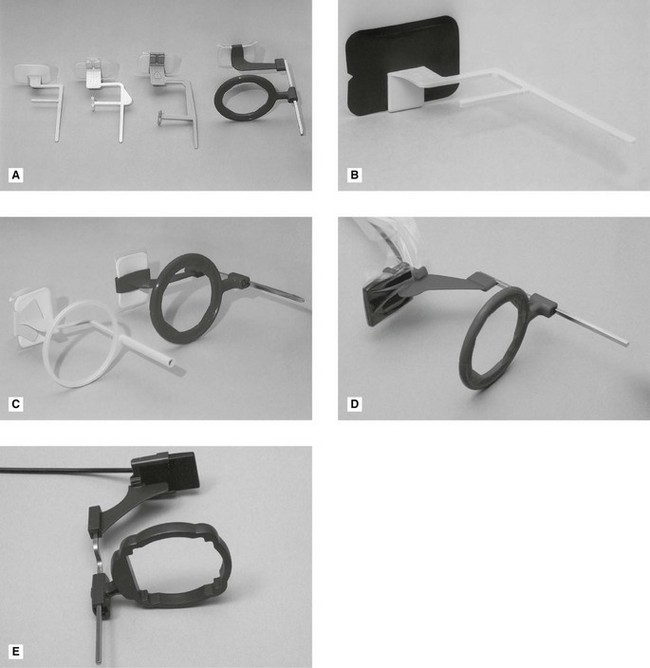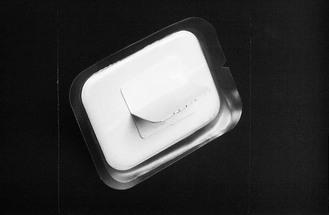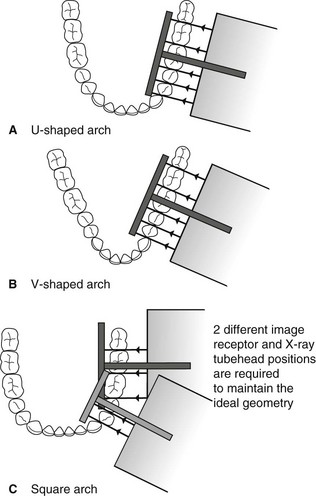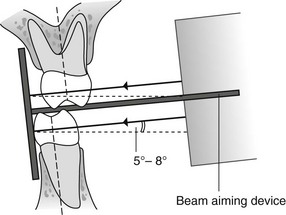Bitewing radiography
Bitewing radiographs take their name from the original technique which required the patient to bite on a small wing attached to an intraoral film packet (see Fig. 8.1). Modern film holders, as shown later, have eliminated the need for the wing (now termed a tab), and digital image receptors (solid-state or phosphor plate) can be used instead of film, but the terminology and clinical indications have remained the same. An individual image is designed to show the crowns of the premolar and molar teeth on one side of the jaws.
Ideal technique requirements
• An appropriate image receptor holder with beam-aiming device should be used and is recommended in the UK in the 2001 Guidance Notes for Dental Practitioners on the Safe Use of X-ray Equipment.
• The image receptor should be positioned centrally within the holder with the upper and lower edges of the image receptor parallel to the bite platform.
• The image receptor should be positioned with its long axis horizontally for a horizontal bitewing or vertically for a vertical bitewing (Fig. 8.2).
• The posterior teeth and the image receptor should be in contact or as close together as possible.
• The posterior teeth and the image receptor should be parallel – the shape of the dental arch may necessitate two separate image receptor positions to achieve this requirement for the premolars and the molars (Fig. 8.3).
• The beam-aiming device should ensure that in the horizontal plane the X-ray tubehead is aimed so that the beam meets the teeth and the image receptor at right angles, and passes directly through all the contact areas (Fig. 8.3).
• The beam-aiming device should ensure that in the vertical plane the X-ray tubehead is aimed downwards (approximately 5°–8° to the horizontal) to compensate for the upwardly rising curve of Monson (Fig. 8.4).
Positioning techniques
Using image receptor holders with beam-aiming devices
Several image receptor holders with different beam-aiming devices have been produced for use with film packets or digital phosphor plates and with digital solid-state sensors, held either horizontally or vertically. A selection of different holders is shown in Fig. 8.5. As in periapical radiography, the choice of holder is a matter of personal preference and dependent upon the type of image receptors being employed. The various holders vary in cost and design but essentially consist of the same three basic components that make up periapical holders (see Ch. 7), namely:

Fig. 8.5 Bitewing image receptor holders with beam-aiming devices. A A selection of horizontal bitewing holders set-up using a film packet as the image receptor – note the red colour coding for the Rinn XCP System. B The Hawe–Neos Kwikbite horizontal holder set-up using a digital phosphor plate. C Vertical bitewing holders – the red Rinn XCP holder and the yellow Hawe–Neos Parobite holder set-up using film packets. D The red Rinn XCP-DS horizontal bitewing solid-state digital sensor holder. E The Planmeca horizontal bitewing holder designed specifically for use with their dixi2 solid-state digital sensors. (See colour plates section)
• A mechanism for holding the image receptor parallel to the teeth
The radiographic technique can be summarized as follows:
1. The desired holder is selected together with an appropriate-sized image receptor – typically a 31 × 41 mm film packet or phosphor plate or the equivalent sized solid-state sensor.
2. The patient is positioned with the head supported and with the occlusal plane horizontal.
3. The holder is inserted carefully into the lingual sulcus opposite the posterior teeth.
4. The anterior edge of the image receptor should be positioned opposite the distal aspect of the lower canine – in this position the image receptor extends usually just beyond the mesial aspect of the lower third molar (see Fig. 8.6).
5. The patient is asked to close the teeth firmly together onto the bite platform. (Note: Extra care needs to be taken of solid-state sensor cables.)
6. The X-ray tubehead is aligned accurately using the beam-aiming device to a/>
Stay updated, free dental videos. Join our Telegram channel

VIDEdental - Online dental courses







